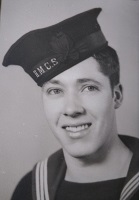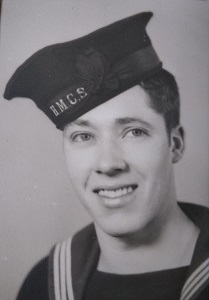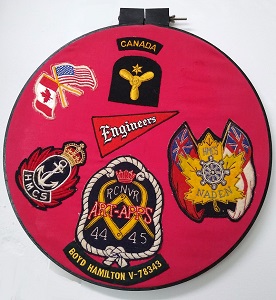|
A Royal Canadian Navy Historical Project
In memory of those who have Crossed the Bar
Boyd was from Tisdale, SK.
Click on the above photo to view larger images
Excerpts from "The Life and Times of Boyd N. Hamilton. 1997"
UNLOADING THE HONG KONG P.O.W.S. 1945 In the fall, after harvest, in October 1941 the Canadian Government made a sweep looking for men for the Army. Tisdale, Saskatchewan was a part of that area and so several young men joined up. As soon as they were in, they were rushed off to Hong Kong, China. Some didn't have uniforms yet and practically none had complete their basic training. Here in Hong Kong, they had their uniforms altered to fit and they completed their basic training, even learning a little rifle drill. December 7, 1941 the Japanese attacked Pearl Harbor. The following day, December 8, they attacked Hong Kong. I have since learned the Japs attacked Hong Kong at exactly the same time but because of the international date line it seemed to be the next day. Of course every Canadian soldier that was not killed was immediately taken prisoner of war. These young Canadian, and, as I learned later, Australians and some of the others were kept as prisoners in Hong Kong or were shipped back to Japan. There they spent the entire war as prisoners in deplorable conditions. When the war finally ended on August 14, 1945 the Americans went into Japan and released those prisoners still alive. Some were ambulatory but many were stretcher cases. As soon as possible these Canadian P.O.W.S. were returned to Canada on returning American troop ships. I was in the Canadian Navy stationed at HMCS Naden in Esquimalt, British Columbia, which is near Victoria on Vancouver Island when one of these returning troop ships arrived back. There were thousands of returning G.I.'s on that ship. There were at least four decks and everyone crowded three or four deep just trying to see. The first thing they did when that ship tied up was to lower two huge gangplanks to the dock. As soon as the gangplanks were secure they started bringing down the ex-P.O.W.S. on the stretchers. It was then i became aware of a huge line of ambulances that stretched as far as I could see. The line must have been a half mile long. I had no idea where so many ambulances could have come from. An ambulance pulled up to each gangplank and either two or four stretchers were placed inside depending on the size of the ambulance, a sick bay tiffy climbed in with them and they pulled away. Immediately, another ambulance pulled up to the gangplank and the off loading continued. The line of stretchers coming down the two gangplanks never slowed. There were several of us young sailors and we had a dialogue going with the G.I.'s on board. I shinnied up a hawser and was on deck for a while. I tried unsuccessfully to acquire one of those fancy Japanese swords that were being brought back for souvenirs. Back on the dock we were showered with Japanese occupation money, pictures of naked girls, and even the odd American sailor's hat. These were all good souvenirs It seemed like we were short of anything to return the favors until we spied two semi-truck loads of apples sitting on the dock. I was certainly one of the first, if not the first to pry the top off a box and started pitching up good Canadian apples. Boy, were they popular. The whole side of that tremendous ship was covered with outstretched arms trying to catch our apples. Before all the stretchers had been taken down the gangplanks those two load of apples had been pitches up to eager, outstretched hands. It was a sad day to see all those young men in such a deplorable condition but there seemed to be nothing we could do to help. However, the good-will and exhilaration that was generated between our two countries by the sharing of those apples was tremendous. We went to sleep in our hammocks that night, sadder because we had seen so many young men that had been devastated by the war. We did though have a good feeling for having shared with our good neighbours to the south. The P.O.W.S. that were in fairly good condition were put in any empty bed that could be found around in the barracks. None were put in with us as we slept in hammocks. Most of them were about 22 or 23 years old, thin beyond belief and many were shaky. Of course we all crowded round them ear to by them a beer, and listen to their stories. Many were so shaky in fact that it took two hands to hold a glass of beer so they could take a drink. Any soldier that managed to drink a whole glass of beer was drunk. They were just all burned out inside, they had no resistance left. It was sad indeed to think of how many people had died and the suffering that had been caused by the war.
THE WETTING OF JOHNS - A NAVY PRANK It was early 1945 and we had just been shipped from Cornwallis, Nova Scotia to Esquimalt, near Victoria, British Columbia. There were about 100 of us, E.R.A.s (Engine Room Artificers), R.C.N.V.R. (Royal Canadian Navy Volunteer Reserve), and we were all put in a large room or barracks. There we no beds and no furniture. The building was about 28' wide and 200' long. Along each side about seven feet off the floor was a pipe running full length of the building. It was securely fastened and we could tie one end of our hammocks to it. Down the centre a row of posts, one about every twelve feet, held the roof up. A pipe running post to post from one end of the building to the other was in place to fasten the other end of our hammocks to. At night one could walk to the other end of the building by ducking under with row of hammocks. One of our group, Johns, decided it was a lot of trouble to get in and out of his hammock at near six feet above the floor. He decided instead to tie his hammock between two of the vertical posts down the centre. Not only that, he put his hammock directly below one of the three ceiling fans that blew air from the attic into the room. To make it more comfy he slung it so low that it could be used as a big soft chair with his feet on the floor. Of course, anyone with such comforts drew instant attention for his close by ship mates. Several ideas were advanced to upset Johns' superior comforts. I happened to sleep on the very end of the line, quite some distance from Johns. Right next to me was a square hole in the ceiling that gave access to the attic. One night as we were all preparing to sling our hammocks and roll in for the night, I was approached by one of Johns' "friends?". he drew my attention to a short string that hung from the attic, near my hammock. "Hammy", he said, "after lights out how about giving that string a slight pull?" Being of a suspicious nature, I insisted he tell me what would happen when I gave a slight pull on the string. He took me outside, away from all other ears and explained the scheme. They had found a two quart milk bottle that they had filled with water. Then they carried it up into the attic and set in on the protective screen above the fan directly over Johns' hammock. A long string tied to the neck of the bottle would cause it to tip over when it was pulled. Its contents would be dumped into the whirling fan which of course would throw it directly into the upturned face and body of Johns'. It sounded good, so I agreed. Some 15-20 minutes after lights out, everyone was in their sack and settled down for the night. I reached over from my hammock in the dark and gave the string a gentle pull. Suddenly, all hell broke loose. Johns came flying out of his hammock, cursing and swearing and dripping with water from head to toe. He turned on all the lights, sure that someone had dumped water on him. No one was out of their sack. A few were even asleep and all wanted to know what the rukus was about. After much ado he came to the conclusion that a pipe must have broken somewhere. The water had quit coming down and no one seem guilty of anything. There were only three of us in on the trick so everyone appeared innocent. Probably to this day he doesn't know what really happened.
Courtesy of Fern Roberson
|
 For Posterity's Sake
For Posterity's Sake 


